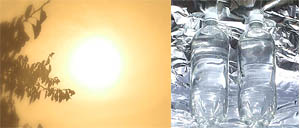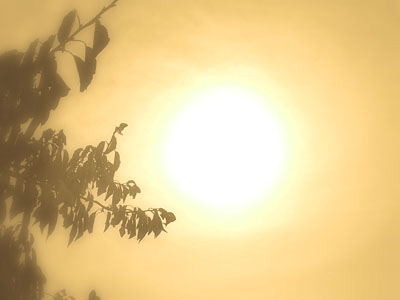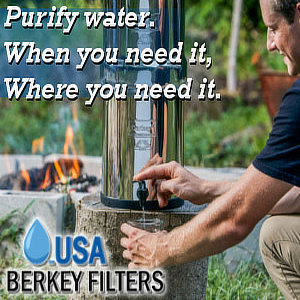Purify Water with Sunlight – Yes, the Sun can Purify Water

Did you know that it is possible to purify water with sunlight? Solar radiation from the sun can purify (organically disinfect) water and make it safe for drinking from harmful bacteria.
Update: I really shouldn’t be using the word “purify”. Rather, sterilize or disinfect (just a technicality). Just pointing it out :=)
Harnessing energy from the sun. Not only can we convert the sun’s energy to electricity by way of photovoltaic panels, but believe it or not…it can be used via the SODIS method to purify water. More on that in a minute…
Harnessing the solar energy from the sun to purify (disinfect) water from a lake or stream into safe drinking water. It is much simpler than you may think. Here’s how…
SODIS Method
The sun can disinfect water. Therefore, in this way made drinkable using the rays of the sun. “Solar water disinfection” – SODIS for short – thus offers a solution for preventing diarrheas’, one of the most common causes of death among people in developing countries.
UV-A rays from the sun, (Ultraviolet-A, longwave, 315-400 nm), will terminate harmful bacteria, parasites, and viruses in water, given enough sun exposure and time.
A clear plastic bottle filled with water, exposed to the sun for 6 hours will make the water safe to drink (although read the caveat list below). In fact, the effectiveness of terminating harmful bacteria can be an amazing 5-Nines, that is, 99.999 percent!
List of Bacteria & Germs killed from UV-A sunlight exposure at 6 hours
- Escherichia coli
- Vibrio cholera
- Salmonella
- Shigella flexneri
- Campylobacter jejuni
- Yersinia enterocolitica
- Virus – Rotavirus
- Parasites – Giardia
- Parasites – Cryptosporidium (needs 10 hours exposure)
List of caveats to UV-A sunlight water purification
- This method kills germs. However, if the water is already contaminated with chemicals from pollution, the chemicals will remain. Know your water source.
- If the water is cloudy and dirty, it should be filtered first to allow the UV-A rays to effectively penetrate into the water.
- The plastic water bottle should be no bigger than 2 liters. In moderately cloudy water, UV-A will lose 50 percent effectiveness at a depth of 10 mm (about 0.5 inch), whereas UV-A will only lose 25 percent effectiveness at a depth of 10 mm in clear water. Just use a typical size soda bottle or water bottle.

How-to purify water with sunlight
The recommended bottle to use is a “PET” bottle. It is very common. Soda bottles. Water bottles. Soft drinks. Etc..
PET, PolyEthylene Terephthalate, Recycle code #1 on bottom of bottle.

Don’t use colored bottles. It must be a clear bottle. Again, it should be a clear plastic bottle (see note below about glass – which is evidently usually okay too). Some types of glass will block too much of the UV-A spectrum for this purpose.
UPDATE: I discovered this during a recent re-check of SODIS information:
Plastic or Glass, Does it matter for UV penetration?
Different types of glass have different chemical and physical properties. Certain types (e.g., quartz glass) have a very high transmittance for UV radiation, while other types (e.g., window glass) effectively filter out this part of the solar spectrum.
All commercial glass bottles used for beverages that were tested so far at Eawag had a UV transmittance comparable to PET bottles, and were, thus, suitable for SODIS. No differences were found in studies of glass and PET bottles that compared their SODIS effectiveness.It is possible, however, that certain glass bottles available in target countries have different UV transmittance properties, and we recommend testing UV transmittance of locally available bottles before promoting them widely for SODIS use. Glass bottles also have certain disadvantages compared to PET bottles which include their greater weight and risk of breaking, limited availability in suitable sizes, and the lack of reusable caps.
Instructions
The bottle must be clean. Common Sense.
Know your water source (as best you can)… if you believe it to be chemically toxic, don’t use it.
Fill the bottle with water. Is the water cloudy with sediment? If the water is very cloudy, it must be filtered by first. Pour water through a cloth or such material to capture the sediment.
Lay the bottle down in the sun. Do not stand them up. Ideally the bottles would by placed so that they face the the sun at a similar angle, to maximize the UV-A penetration.
Even better… lie the bottles on a reflective surface to increase the UV-A exposure using direct and reflected sunlight. This is not necessary, however it would shorten the required time and ensure optimum UV-A exposure.
If the sky is mostly sunny / partly cloudy with just a few clouds, then 6 hours of sunlight exposure will be enough. However, when the sky has more clouds than sun, several days may be required. So, in this regard, the amount of sun time is variable.
Note that the outdoor temperature does not matter, so long as the UV-A sunlight exposure has been 6 hours.
Notes
An excellent source for more information on this subject:
Swiss Federal Institute of Aquatic Sciences and Technology.
The WHO (World Health Organization) states that the limiting values (plasticizers) for drinking water are never exceeded when using PET bottles for this method.
Remove sediment or other particulate matter first, by a filtering process.
Solar water disinfection if performed correctly will eliminate organic contaminants from impure water. Water that contains non-biological contaminants (heavy metals, etc..) may require filtering. One of the best drinking water filters today is the Berkey drinking water filter.

